The Bay Area’s “innovation economy” — i.e., the high-tech sector — is thriving. Though longtime observers are right to wonder when the next crash will happen, the region’s current boom has some fundamental qualities — such as profitable companies and growing venture capital funding — that hint a bust is not imminent. Two recent reports, the 2015 Silicon Valley Competitiveness and Innovation Project from the Silicon Valley Leadership Group and Joint Venture: Silicon Valley’s 2015 Silicon Valley Index, highlight key strengths and several challenges facing the region. Below are some of the conclusions from these two reports.
Silicon Valley is in its fifth wave of innovation, driven by social media.
For more than 60 years Silicon Valley’s economy has been at the forefront of various breakthrough technologies that have reshaped existing industries or invented new ones. Throughout the history of the region, the leading technologies or innovations have varied considerably. A chart in the Competitiveness and Innovation Project report highlights the technologies and investments that drove the five major “waves” of Silicon Valley — from defense to integrated circuits to the personal computer to the Internet to social media. The upshot: We are in the fifth wave of innovation in Silicon Valley, with significant growth since 2005 being led by social media as well as apps, medical devices, mobile technologies and clean technologies.
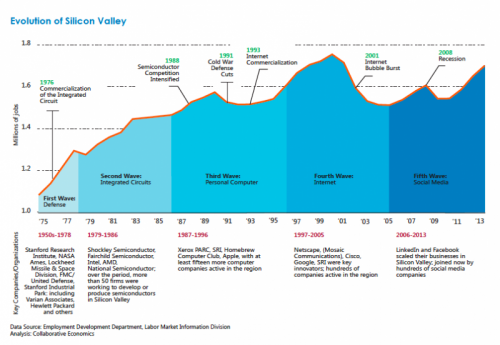
Source: Silicon Valley Leadership Group and Silicon Valley Community Foundation, Silicon Valley Competitiveness and Innovation Project - 2015
Click to enlarge chart >>
Silicon Valley is capturing an increasing share of venture capital relative to other regions.
Overall employment in our tech sector now exceeds pre-recession levels, and there have been sharp increases in venture capital investment since 2013. In 2014, 30 percent of venture capital deals and 46 percent of total investment nationwide took place in Silicon Valley, and the number of registered patents in the region doubled between 2003 and 2013.
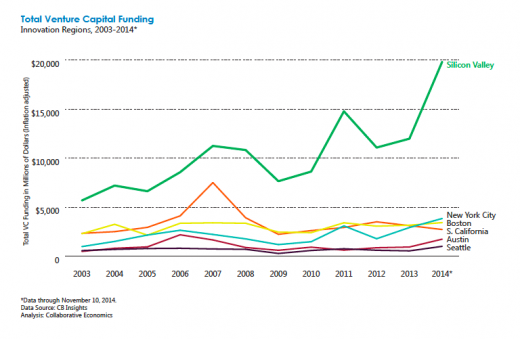
Source: Silicon Valley Leadership Group and Silicon Valley Community Foundation, Silicon Valley Competitiveness and Innovation Project - 2015
Click to enlarge chart >>
Despite the region’s high costs, productivity outpaces that in peer regions.
The Bay Area continues to lead the nation in both start-up capital and worker productivity. Metropolitan areas in San Francisco and San Jose have the highest annual output per-worker compared with other innovation centers. These high productivity levels make the region an attractive place for entrepreneurs, even with the high cost of doing business here.
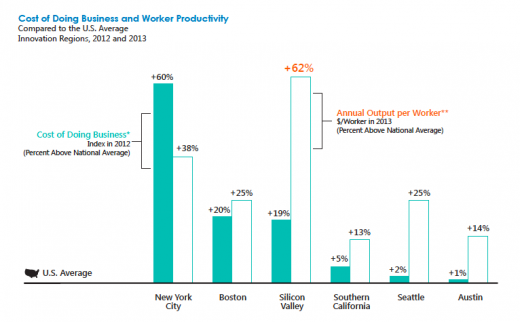
Source: Silicon Valley Leadership Group and Silicon Valley Community Foundation, Silicon Valley Competitiveness and Innovation Project - 2015
Click to enlarge chart >>
But other regions are increasing their spending on research and development much faster.
Slowing growth in spending on research and development (R&D) threatens Bay Area prosperity. Spending on R& Dis not growing as quickly in Silicon Valley as it is in competing high-tech cities. This funding provides a critical backbone for bringing innovative technologies to market. Less R&D spending today may result in fewer breakthroughs, and hence fewer jobs, in the future.
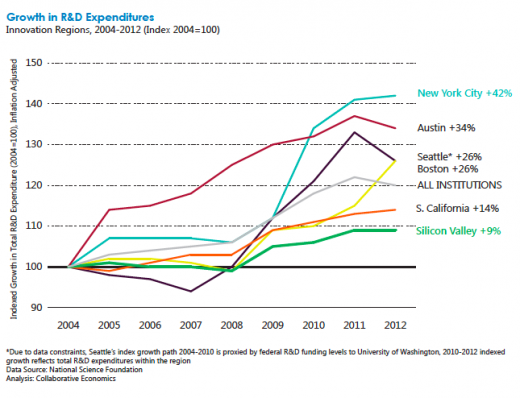
Source: Silicon Valley Leadership Group and Silicon Valley Community Foundation, Silicon Valley Competitiveness and Innovation Project - 2015
Click to enlarge chart >>
Income disparity is increasing as the middle declines.
This time of expansion is also an opportunity to acknowledge the challenges associated with economic growth. Despite a robust economy in 2014, income disparity continues to undermine regional prosperity. Job growth is occurring primarily at the top and bottom tiers of the wage scale, and the share of mid-wage jobs has declined by 4.5 percent in Silicon Valley since 2001.
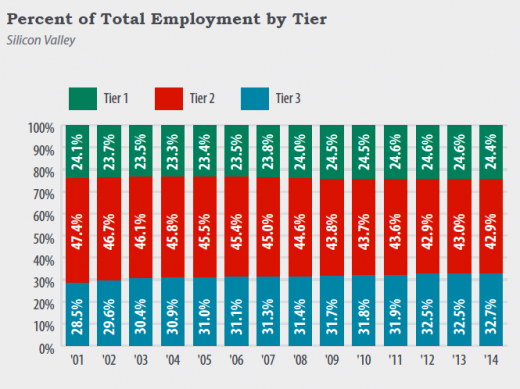
Source: Joint Venture Silicon Valley, 2015 Silicon Valley Index
Click to enlarge chart >>
As outlined in SPUR’s Economic Prosperity Strategy, job mobility for low- to moderate-wage workers and access to middle-income jobs are critical for an economy that will thrive over the long term. In the Bay Area’s knowledge-based market, the increased skill and productivity associated with upward mobility is also essential for maintaining our competitive edge.
According to the SVLG report, only 59 percent of 3rd graders and 54 percent of 8th graders scored proficient in reading and algebra, respectively, in Silicon Valley.
With the population growing, decreased access to affordable housing and public transportation are two additional challenges that affect prosperity. Housing prices jumped 33 percent in Silicon Valley between 2012 and 2014, and time spent travelling to and from work is rising faster here than in other innovation regions. Affordable housing for employees is a top concern for Silicon Valley managers, as quality of life is an important factor in attracting and maintaining top talent.
Conclusion
In the early 1980s, noted author and Silicon Valley researcher AnnaLee Saxenian wrote a master’s thesis arguing that Silicon Valley’s future was threatened and would stop growing, as it had become too expensive and too congested. She has often acknowledged how this prediction was inaccurate. More than three decades later, we are still growing in spite of these still present challenges.
Perhaps most important, the region’s current strengths — as well as its economic threats — are a cue to invest in proposals that create a more resilient economy. The private sector should use revenue to make long-term investments in R&D. In the public sector, cities should set money aside for rainy day funds and increase spending on needed infrastructure projects. Congested freeways and booming Caltrain ridership is a signal that we need to significantly grow transit capacity — particularly Caltrain.
And of course, cities need to allow much more housing in their communities as the undersupply of housing remains the greatest long-term threat to competitiveness.
Tech is driving regional prosperity right now, but this position is not assured. It is important to invest in strategies during the boom times that will create a foundation for regional prosperity during the inevitable busts that follow.
Read the Silicon Valley Leadership Group’s 2015 Silicon Valley Competitiveness and Innovation Project >>
Read Joint Venture: Silicon Valley’s 2015 Silicon Valley Index >>
